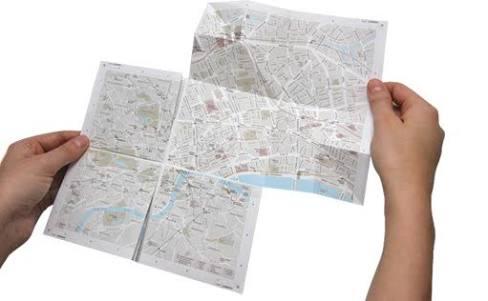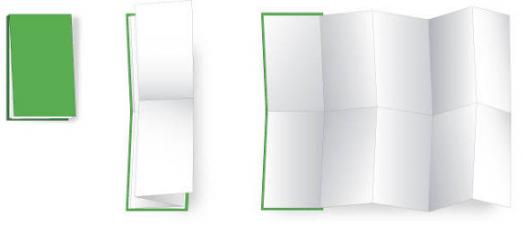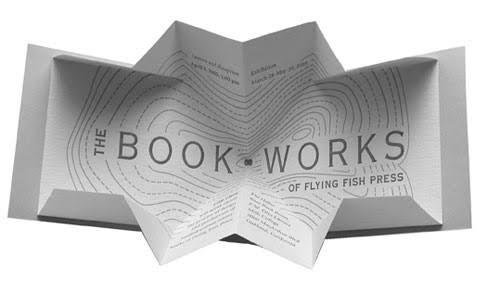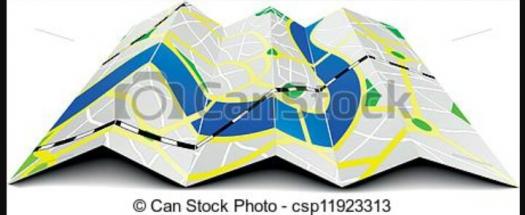What Do You Know About Map Folding?

Map folding is a subtopic in the mathematics of paper folding, which is greatly associated with stamp folding. It simply is a problem in which you have to track the number of ways a piece of paper can be folded. Even though it can used for most types of paper, it is geared towards the number of ways a piece of map can be folded. Now, let's see what you know about map folding in the quiz below.
- 1.
When the paper in a map is divided by creases, which shape does it form?
- A.
Circles
- B.
Rectangles
- C.
Squares
- D.
Triangles
Correct Answer
B. RectanglesExplanation
When a paper in a map is divided by creases, it forms rectangles. This is because creases create straight lines that intersect at right angles, resulting in the formation of rectangular shapes. Circles cannot be formed by creases, as they require curved lines. Squares can only be formed if the creases are of equal length on all sides, which is not specified in the question. Triangles cannot be formed by creases alone, as they require at least three creases to intersect at a single point. Therefore, the correct answer is rectangles.Rate this question:
-
- 2.
How best can you explain map folding?
- A.
It is the probability of how many times a map can be folded
- B.
It is a mathematical problem that shows the number of times a paper can be folded
- C.
It is the number of times a problem can be solved
- D.
It simply is the mathematics of folding maps and other papers
Correct Answer
B. It is a mathematical problem that shows the number of times a paper can be foldedExplanation
Map folding is a mathematical problem that explores the maximum number of times a paper can be folded. This problem involves mathematical principles such as exponential growth and geometric progression to determine the limit of foldability. It is not about the probability of folding or the number of times a problem can be solved, but specifically focuses on the physical act of folding a paper.Rate this question:
-
- 3.
Which mathematician is credited for formulating the map folding problem?
- A.
Émile Lemoine
- B.
Richie Moore
- C.
Girard Desargues
- D.
Nikolai Lobachevsky
Correct Answer
A. Émile LemoineExplanation
Émile Lemoine is credited for formulating the map folding problem.Rate this question:
-
- 4.
What separates the paper to be folded in a stamp folding problem?
- A.
Pleats
- B.
Lines
- C.
Creases
- D.
Grooves
Correct Answer
C. CreasesExplanation
In a stamp folding problem, the paper is separated by creases. Creases are the lines or folds made on the paper to create different sections or compartments. These creases act as guidelines for folding the paper in a specific way to achieve the desired shape or pattern. Pleats, lines, and grooves are not the correct terms to describe the separation of the paper in a stamp folding problem.Rate this question:
-
- 5.
The known method for calculating the map folding numbers takes which equation as its function?
- A.
Linear algebra
- B.
Exponential time
- C.
Functional analysis
- D.
Polynomial time
Correct Answer
B. Exponential timeExplanation
The known method for calculating the map folding numbers takes the equation as its function. This suggests that the process of calculating map folding numbers is time-consuming and grows exponentially with the size of the map. Linear algebra, functional analysis, and polynomial time are not specifically mentioned in relation to the method for calculating map folding numbers.Rate this question:
-
- 6.
In how many ways can you fold a 2 × 2 map along its creases?
- A.
Two
- B.
Four
- C.
Six
- D.
Eight
Correct Answer
D. EightExplanation
A 2x2 map can be folded along its creases in eight different ways. This can be visualized by considering each corner of the map as a pivot point and folding the map in half along each of the four creases. Additionally, the map can be rotated 180 degrees before folding, resulting in four more folding possibilities. Thus, there are a total of eight ways to fold a 2x2 map.Rate this question:
-
- 7.
How do express the number of ways to fold an n × n map?
- A.
N ≤ 5
- B.
N ≤ 6
- C.
N ≤ 15
- D.
N ≤ 20
Correct Answer
A. N ≤ 5Explanation
The given answer "n ≤ 5" suggests that the number of ways to fold an n × n map is limited to a maximum of 5. This means that for any value of n, the number of possible ways to fold the map will not exceed 5. It implies that there are a limited number of folding patterns or configurations that can be achieved for any given size of the map.Rate this question:
-
- 8.
In map folding, what is polynomial algorithm used for?
- A.
N x 15 maps
- B.
8 x n maps
- C.
N x n maps
- D.
2 × n maps
Correct Answer
D. 2 × n mapsExplanation
The polynomial algorithm is used for 2 × n maps in map folding. This means that the algorithm can efficiently handle folding maps that have dimensions of 2 times the number of elements in the map. This algorithm is designed to fold the maps in a polynomial time complexity, which means that the time it takes to fold the maps increases at a polynomial rate as the size of the map increases.Rate this question:
-
- 9.
What are the creases of every one-dimensional strip of stamps labelled as?
- A.
Mountain folds
- B.
Crease folds
- C.
Exponential folds
- D.
Hightop folds
Correct Answer
A. Mountain foldsExplanation
The creases of every one-dimensional strip of stamps are labelled as "Mountain folds." This term refers to a type of fold where the paper is folded upwards, creating a peak or mountain-like shape. It is commonly used in origami and paper crafts to add dimension and structure to the paper.Rate this question:
-
- 10.
In another variation of the stamp folding problem, what is the strip of stamps considered to be?
- A.
Blank
- B.
Filled
- C.
Solid
- D.
Half-flled
Correct Answer
A. BlankExplanation
In the stamp folding problem, the strip of stamps is considered to be "Blank". This means that the strip of stamps does not have any markings or designs on it. It is simply a plain strip of paper that can be folded in various ways to create different patterns.Rate this question:
-
Quiz Review Timeline +
Our quizzes are rigorously reviewed, monitored and continuously updated by our expert board to maintain accuracy, relevance, and timeliness.
-
Current Version
-
Mar 20, 2023Quiz Edited by
ProProfs Editorial Team -
May 11, 2018Quiz Created by
AdeKoju
- Cartography Quizzes
- Civics Quizzes
- Economics Quizzes
- El112 Quizzes
- English Quizzes
- Geography Quizzes
- History Quizzes
- Humanities Quizzes
- Law Quizzes
- Linguistics Quizzes
- Logic Quizzes
- Philosophy Quizzes
- Political Science Quizzes
- Politics Quizzes
- Science Quizzes
- Social Science Quizzes
- Sociology Quizzes
 Back to top
Back to top












